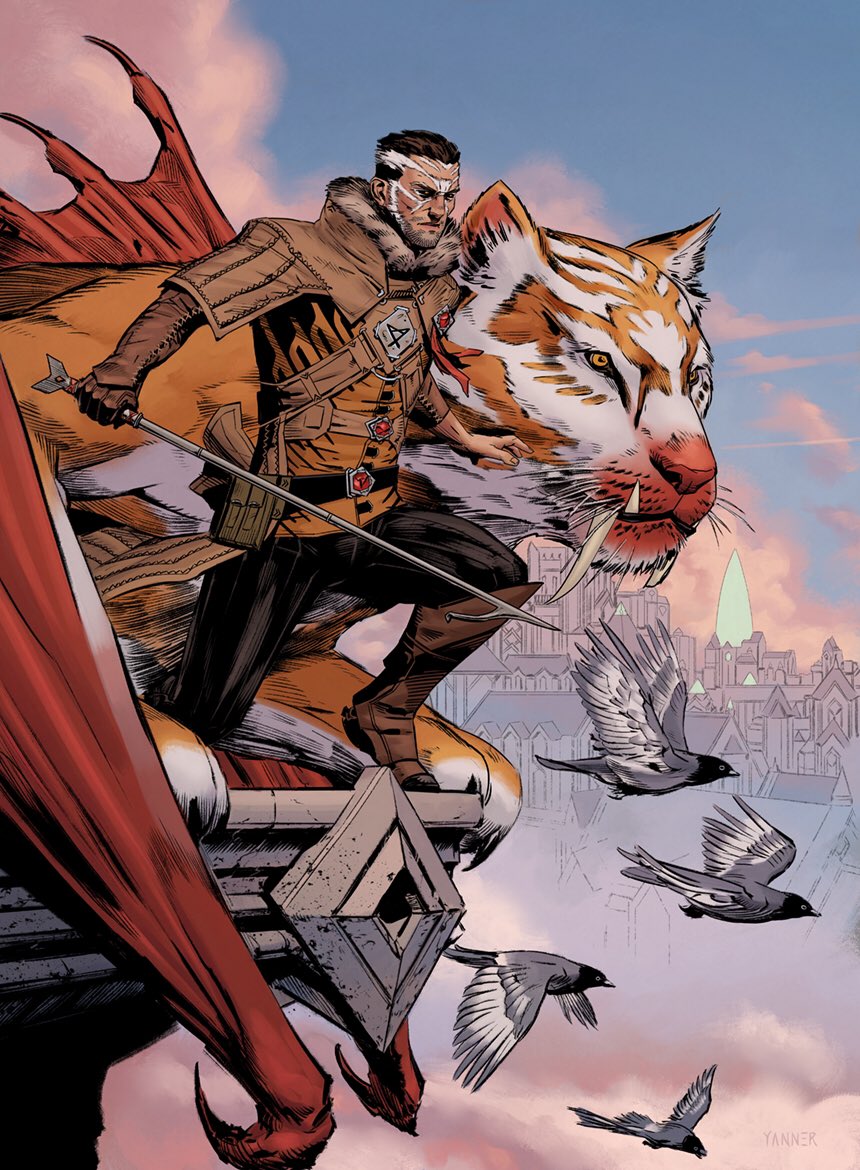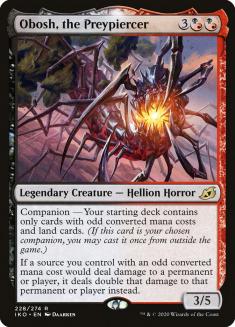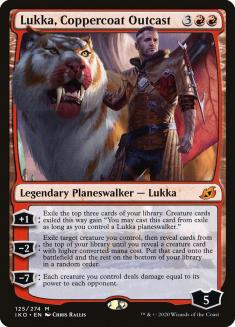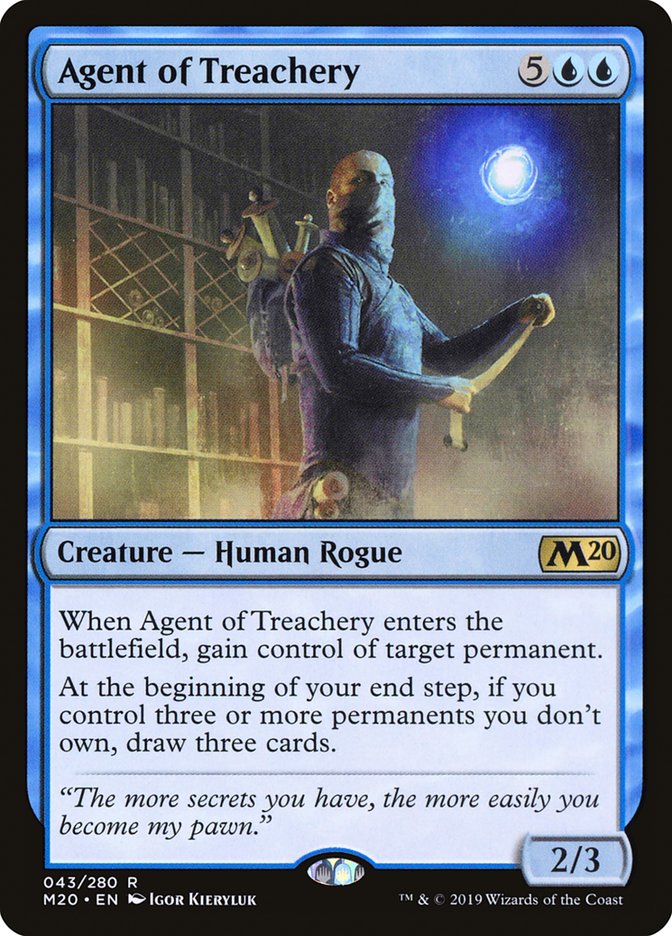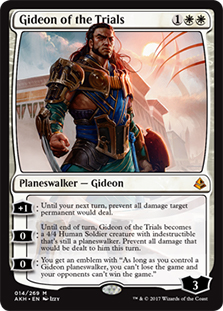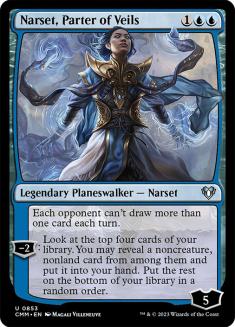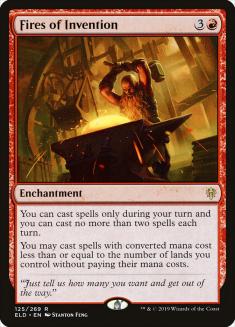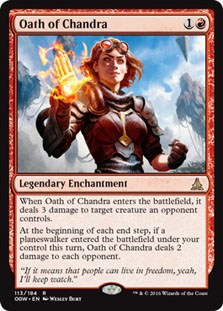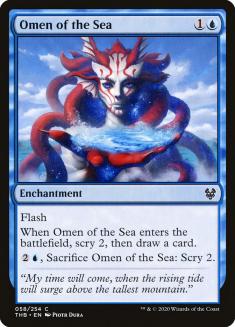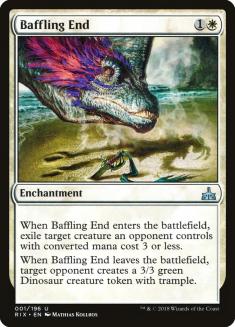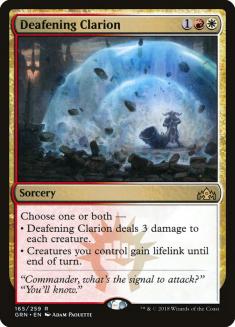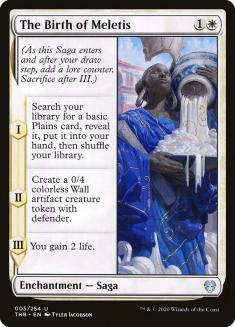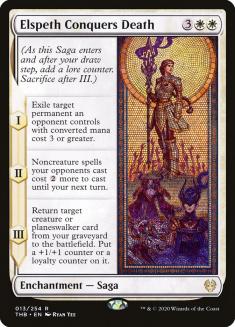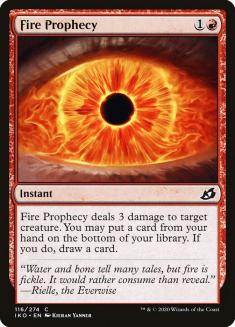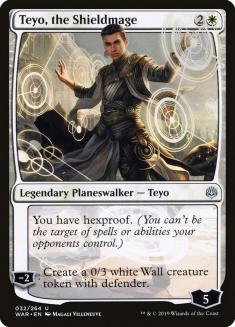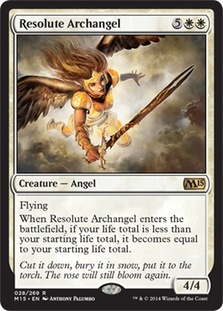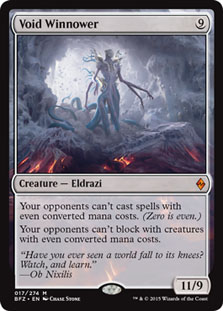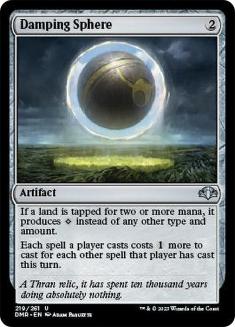While companions are overwhelming some formats and creating spaces that are less than desirable, I’d argue heavily in favor of them for gameplay in Pioneer. Before companions, the top three decks were all combo-oriented, and two of those were able to play stellar mid-games while having a combo finish. If you weren’t getting solitaire’d by Lotus Field, you were getting ripped apart by Thoughtseize into Inverter of Truth.
After the introduction of companions, something started to happen that wasn’t all that prevalent in Pioneer for the last few months: people started to play more creatures. Companions inherently promote more combat, more removal, and longer games. The extra card means mulligans hurt less and you have more decisions each game than normal. The fact that the extra card is a creature means you usually need more creatures in order to make it viable.
More creatures mean more combat, more removal, and more interaction – more of the magic that makes it Magic. When everyone is playing combo or combo-adjacent, the gameplay becomes a bit weird. Sometimes you’d draw your counterspells in the right order and stop what the opponent was doing. Occasionally you’d draw a Thoughtseize and apply enough pressure or draw Damping Sphere. But rarely were the games all that fun or interesting. Playing against combo every now and then is pretty fun because it provides dynamic decisions, and that small window matters greatly. Playing against combo every round gets incredibly frustrating and tiring as you start to have one-sided games. Win or lose, it doesn’t feel like either of you made any interesting choices.
Combo decks that play mostly from hand as opposed to putting all their pieces on the battlefield over time are also quite weird to grasp. Something like Dimir Inverter doesn’t really look like it’s killing you until you’re dead. Up until that point, they’re stripping you of interaction, killing creatures via Fatal Push, and sometimes even stopping your development via Censor or Mystical Dispute. It’s unlike any other combo deck in the format because it’s hyper-interactive, playing much like a Dimir Control deck until you suddenly lose to the one-two punch.
Companions might be ubiquitous across every Magic format, but I have yet to play a match against Lurrus or Obosh or even Yorion that was less interesting than every match I’ve ever played against Lotus Field or Dimir Inverter. Are the companions too good? Yeah probably. I wouldn’t be surprised to see multiple banned or the mechanic reworked. But what I really want to stress is this:
Pioneer is a much better format with companions.
While Lurrus and Yorion are the dominant companions in Pioneer, the gameplay they both provide is both more fun and more desirable than the combo-centric hellscape we’ve come to loathe. Having both Lurrus and Yorion be viable and on top of the food chain influences the rest of the format, opening up avenues for other companions or other archetypes to shine. And while these two companions are currently the peak, there are a ton of different ways to build your deck around them. My favorite Yorion deck at the moment is something I’ve lovingly dubbed Jeskai SuperFires.
Creatures (2)
Planeswalkers (15)
Lands (35)
Spells (28)

To be clear, this original iteration was not my own, but the first time I saw someone blink Fires of Invention with Yorion, Sky Nomad I was hooked. This version was the one I picked up recently, and the one we’ll be making some changes to as we progress. The core of the deck is pretty strong, but my gut says we can make some slight alterations to make this thing a real monster.
This combination is heavily influencing Ikoria Standard at the moment, and it’s no surprise that it was powerful enough to bleed into Pioneer. Stealing your opponent’s stuff at the low cost of losing a token-based creature and two loyalty from a planeswalker is outstanding. The reason why this combination is so frustrating is that you can’t get that permanent back, even if you kill the Agent of Treachery. Stealing lands is also pretty effective depending on the situation, and much harder for your opponent to “undo” via Teferi, Time Raveler or another effect.
Lukka, Coppercoat Outcast is another outstanding addition to any Fires of Invention deck, giving you a big payoff that’s relatively easy to cast if you don’t actually draw said Fires of Invention. The coolest part about Lukka is actually the threat of his ability, because if he’s already on the battlefield then it becomes pretty tough for your opponent to do much of anything before they kill it. If they don’t kill it, you’re usually threatening to steal one thing with Agent of Treachery and another thing when you cast Yorion and blink it.
This one has been impressive in a few different archetypes already, but the truth is that you need to use your mana, even when Fires of Invention is going off. In fact, the more mana you get to spend while Fires of Invention is active just pushes any advantage you’ve already gained that much farther. Shark Typhoon works doubly so here, as you can cast it and another big spell with Fires of Invention and start creating huge Sharks or cycle it if you need some more juice. Being able to cycle it and make a surprise blocker while Fires of Invention is out is also a neat little trick that will get most opponents the first time you do it.
Shark Typhoon isn’t as good here as it is in Jeskai Cycling, but it’s certainly important to the overall strategy. There aren’t a ton of different ways to use your mana while Fires of Invention is active, so it’s nice to have such a powerful and versatile card in your arsenal. It’s a great tool for combating an opposing Teferi, Time Raveler or Narset, Parter of Veils, but it’s also just an easy way to win games if you draw one or two in the later turns. The fact that it cycles continues to press any advantage you previously held, while also giving you a precious resource back if you’re behind. The only point in which it isn’t too good is when you have to cycle it for two or three mana.
This one is pretty solid against a number of opponents, but the truth is that it insulates you from Dimir Inverter. The other upsides: it pressures opposing planeswalkers, forces opponents to overextend into Supreme Verdict, and is a creature for Lukka to turn into Agent of Treachery. It’s worthwhile and pretty strong.
One of the backbones of the archetype, Narset continues to give you juice while you have Fires of Invention active. Since we aren’t playing many creatures, Narset can find virtually anything you need to get the job done. Since we’re playing Yorion, we actually have a way to blink Narset once it gets down to one loyalty, which is pretty ridiculous considering how powerful the minus ability is.
The static ability of Narset is exceptional against the combo decks in the format, and also pretty nice against any opposing Yorion strategies. It isn’t at its best against aggressive decks, but it usually replaces itself and soaks a few points of damage. If it finds Supreme Verdict along the way, that’s just icing on the cake.
Narset is your most important card in a lot of matchups. While I wouldn’t mulligan to it specifically, it providing that powerful static ability while digging for more spells is outrageous. It’s just comically good, as the static ability effectively strangles the development of multiple archetypes.
Teferi is one of the biggest reasons to play Fires of Invention. There’s a reason that they’re almost always paired together, as the “tempo” nature of Teferi where you bounce something and draw a card is huge. Shutting down your opponent’s ability to interact on your turn also means you get to some cool stuff without fear of interaction. In some ways, when you’re in control of Teferi, it’s one of the best feelings. The lack of interaction means you get to do the cool thing!
I don’t need to describe why Teferi is dope. You should already know that by now. It’s a multi-format all-star that reshapes how we play the game. Many people, including myself, dislike the play patterns and how the static invalidates multiple strategies and makes cards stop working. Regardless, it’s still legal and it’s a tool we should utilize in a Fires of Invention deck.
Speaking of Fires of Invention, this is the engine the deck is built around. Not only is it mana-neutral on the turn you cast it, but it starts to let you do some silly things once you really get going. As I talked about earlier, one main goal is to figure out how to use extra mana while Fires of Invention is active. Castle Vantress and Castle Ardenvale are great, but playing too many of those means you have lands enter the battlefield tapped too often. Shark Typhoon is one of the bigger payoffs for Fires of Invention that I’ve seen.
But the coolest part of Fires of Invention is being able to blink it for one turn with Yorion. Yorion can be cast via Fires of Invention as your second spell, and you can use the ability to blink Fires of Invention out of existence for the turn, which lets you use your mana to cast more spells. That one turn where you get double mana and get to cast a bunch of spells from hand is ridiculous. This deck almost never runs out of stuff to do, as most of your cards cycle or replace themselves or have multiple uses. Having that one turn of reprieve from the two-spell restriction is completely busted.
These early pieces of card draw and interaction are important for making Yorion as powerful as it is. We’ve seen a huge increase in the playability of permanents that function like spells, even if they do something “worse” than their instant or sorcery counterpart. Being a permanent to blink with Yorion is so absurd that Oath of Chandra is better than Lightning Strike, even though Oath of Chandra can’t kill planeswalkers or go to the dome. Similarly, Opt is seeing almost no play right now while Omen of the Sea is all the rage.
Baffling End is a little weirder than the others, as it doesn’t work exactly the same as the others. Instead of getting a freebie removal spell, Baffling End on the rebuy gives your opponent a 3/3 in place of whatever creature you want to target. The front half tagging whatever annoyance in the early turns is great, but being able to “Beast Within” your opponent’s Lurrus later in the game is a huge deal.
This one-two punch of sweepers gives you time against the aggressive decks. And that’s really all you need to win the game, as it’s pretty difficult for most decks in the format to keep up with you. Thanks to being able to maindeck four copies of Narset, you have control over longer games because your opponent can’t match you on resources. These sweeper effects (and the cheap spot removal) give you the breathing room you need to get all your planeswalkers online.
Supreme Verdict is the easy one, as it can’t be countered and takes care of just about everything the opponent can throw at you. Deafening Clarion is also valuable, as I’ve used the lifelink multiple times while sweeping opposing creatures to create a gigantic swing turn. It’s also great in the early-game because it’s just slightly cheaper than Supreme Verdict. Against Lurrus decks, Deafening Clarion is usually a bit better than the others because their aggressive nature sometimes requires more action than a sweeper on the fourth turn. Playing against Lurrus Boros Burn specifically, while on the draw, Supreme Verdict is often not fast enough.
It’s important to remember we’re playing an 80-card deck, so having an extra sweeper or two in your list means you’re slightly more likely to draw it, or equally as likely to draw one compared to a 60-card deck. So if you’re used to just packing four sweepers and calling it a day, you might want to add one or three to make your life a bit easier.
This card is surprisingly versatile and important to the overall strategy. Creating a body while providing you with a land is huge, as it smooths out your draw while giving you fodder for Lukka. The lifegain at the end is also pretty solid against aggressive strategies. Overall, I love this card in control decks of all sorts. It’s almost like a Wall of Omens had a baby with Civic Wayfinder. It’s glorious. It’s simple. It’s maybe the only perfect Saga.
If the format is full of midrange Yorion decks, Elspeth Conquers Death (ECD) is a ridiculous card. However, my experience as of late suggests that those decks are on the downswing. I’d say that Lurrus and various combo decks are more prevalent, which means ECD has few if any real targets other than Lurrus itself. Of all the cards in the maindeck, this is the one I’d like to cut the most. I don’t think it’s quite good enough to play in the sideboard, and it doesn’t have enough targets to justify in the maindeck.
Back when everyone was playing Yorion and Heliod, ECD was outrageous. It’s absolutely devastating to reset with Yorion for a lot of opponents. It’s such a shame that Lurrus influences the format so much, because ECD is a fun and interesting card.
As far as the manabase goes, I haven’t had problems. Raugrin Triome and Irrigated Farmland help turn on Glacial Fortress and the like while also cycling when you’re flooding or don’t need extra lands thanks to Fires of Invention. I wouldn’t change a single land at the moment.
As for specific changes to the archetype, here’s where I would go next:
Creatures (3)
Planeswalkers (15)
Lands (35)
Spells (27)

I wanted to add a third Agent of Treachery, if only because I found games going long enough where I would regularly run out of creatures for Lukka. With that said, you can’t just play three uncastable creatures in your deck, even if it is 80 cards. Fire Prophecy doesn’t quite do the same thing as Baffling End, but it does give you a way to smooth out your draw (pitching an Agent of Treachery back into your deck). Fire Prophecy is an underrated card I’d like to try more of in decks that use burn-based removal to kill creatures and don’t care much about going to the dome.
I was impressed by Teyo, the Shieldmage against Lurrus Boros Burn. Having that planeswalker be a brick wall for both creatures attacking and burn spells targeting the dome gives you a huge life buffer that can’t be overstated. It isn’t the best planeswalker in the world, but it fills a very important role in the sideboard. If you gave me a reason to trim it for something else, I’d definitely listen, but I was pleasantly surprised at how much I liked this card. On top of that, you get multiple bodies for Lukka, and can potentially invalidate entire strategies by giving yourself hexproof.
Lukka also gives you some sweet sideboard options.
We don’t have Griselbrand or even something that hits super-hard like Emrakul, the Aeons Torn, but we do have some fatties that are quite strong. Resolute Archangel gives you a huge life buffer against aggressive strategies. In a lot of cases, that ability is significantly better than stealing an opposing creature. I’ve done some really dirty stuff with Resolute Archangel already, and I’ve only played against aggressive decks a handful of times. Going from three to twenty life against an opponent who just hit you with Boros Charm is incredibly satisfying.
Void Winnower is a completely different monster, but one that can completely lock some opponents out of the game. I wouldn’t sideboard this one in against an opponent who has something like Teferi, Time Raveler or Murderous Rider, but it’s a knockout against a lot of decks. I was impressed at how easy it is to cast, because the games can go pretty long thanks to all the removal and preventative measures.
Mystical Dispute is a great tool for a deck like this, as it functions like Dispel when protecting your own stuff and gives you a buffer against an opposing Narset or Teferi. It’s fantastic against Dimir Inverter, but really shines against opposing control decks.
Damping Sphere is a necessary evil, as Lotus Field might be one of our toughest matchups. I’ve beaten it the one time I played against it, but the first game almost felt like a freebie for them. If you don’t draw Narset, it’s difficult to interact at all. Your spot removal is dead, and most of your late-game resource-building is invalidated because those extra resources are usually just dead removal spells. Damping Sphere isn’t a knockout blow against them, as they have Blast Zone and the occasional Blink of an Eye or Ratchet Bomb, but it can certainly buy you some much-needed time. All you need is to buy a little time until you can get Void Winnower onto the battlefield. Once you’ve accomplished that, it becomes nearly impossible to lose.
This deck is the real deal. I’m under the impression that any deck you can pick up and go 5-0 the first running it is a solid choice for an upcoming tournament. The small changes I made should help smooth out your draws a bit and cut some of the excess fat. Elspeth Conquers Death is a great card, but it’s just not very good right now.
I’ll likely be playing this deck for this weekend’s tournaments. I might make a small change here or there depending on how the alterations feel, but the core strategy is ludicrous. You go over the top of most opponents while simultaneously having the tools to squash the cheap aggressive strategies. The only downside is being a slight underdog to some combo decks, but I don’t even know how bad those matchups are after sideboard. They seem significantly better.
Pioneer has gone through some serious changes in the last month with the introduction of Ikoria: Lair of Behemoths, but the same can be said for every Magic format. Companions are powerful, and they’re likely here to stay. I’m loving the gameplay so far and I’m hoping that optimism stays with me for at least a few more months.

